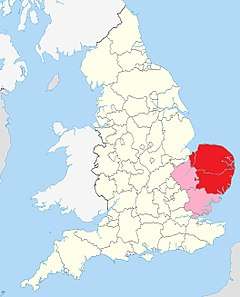East Anglian English
East Anglian English is a dialect of English spoken in East Anglia. East Anglian English has had a very considerable input into the formation of Standard English, and probably contributed to the development of American English; it has also experienced multilingualism on a remarkable scale. However, it has received little attention from the media and is not easily recognized by people from other parts of the UK. East Anglia is not easily defined as its boundaries are not uniformly agreed upon.[1]

Dialects commonly agreed upon include:[1]
- Norfolk dialect (Broad Norfolk)
- Suffolk dialect
Other dialects more loosely associated with East Anglia include:[1]
- Essex dialect
- Cambridgeshire dialect
- Fenland dialect
History
In Jacek Fisiak's and Peter Trudgill's book, East Anglian English, they describe the important influence East Anglian English has had on the development of the English language. In addition to its influence in the Standard English that is known today all around England, it also influenced General American English. There is evidence according to Oxford Dictionary that East Anglian English grammar was heard in North Carolina.[2]
Very little is known about the Anglo-Saxon East Anglian dialect; a Suffolk charter (of Æthelflæd, before 991) is included in Sweet (1946:188–89). The author set out to record elements of the East Anglian dialect and records a statement made by a local when she caught him making notes on the sleeve of his shirt: "Whatever you bin makin' them little owd squiggles on y'r cuff fower?" Bensusan replied that he was "writing history". He then recorded her retort: "You dedn't wanter done that. Telly f'r why. When you've got y'r shirt washed there won't be nawthen left. I've never wrote nawthen all me born days, ne yet me husban', an he got all his teeth an' I kin thread me needle without spectacles. Folk don't wanter write in this world, they wanter do a job o' work."[3]
Accent
Grammar
- Third-person singular zero is the lack of -s in third-person verb conjugations and is considered as the "best-known dialect feature" of East Anglian English. Examples include "she go" or "that say".[4]
- Use of the word do with the meaning of or, or else ,[2] for example "You better go to bed now, do you’ll be tired in the morning"[2]
- That is used in place of central pronoun it, e.g. "that's cloudy", "that's hot out there" and "that book, that's okay, I like it".[5] The final example still uses it, but only when it is the object of a verb.[2]
- Time is used to mean while, for example, "You sit down, time I get dinner ready."[2]
- Now can also mean just, i.e. "I am now leaving" also means "I am just leaving".[5]
Vocabulary
- bishybarnybee — a ladybird[2]
- dag — dew[2]
- dene — the sandy area by the coast[2]
- dickey — the local term to refer to a donkey[2]
- dodman — a term used to refer to a snail[2]
- dow — a pigeon[2]
- dwile — floorcloth[2]
- gays — the pictures printed on a book or a newspaper[2]
- grup — refers to a small trench[2]
- hutkin — used for a finger protecter[2]
- mawkin — a scarecrow[2]
- mawther — local word referring to a girl or young woman[2]
- pit — a pond[2]
- push — a boil or pimple[2]
- quant — punt pole[2]
- ranny — term meaning 'shrew'[2]
- sowpig — a woodlouse[2]
- staithe — an archaic term still used to reference any landing stage[2]
- stroop — the throat[2]
Phonology
Phonological features frequently heard throughout the area include:
- Absence of h-dropping.[6]
- /ɜː/ as in first pronounced [fɐst].[7]
- /ʊ/ as in stone [stʊn][8]
- BATH/PALM/START is a very front vowel unlike London English, where it is a back vowel[8]
- /p, k/ in intervocallic positions are glottalized as in paper or baker, [ˈpæip̬ʔə, ˈbæik̬ʔə]. This is also the case with /t/, later [ˈlæit̬ʔə], but is more commonly completely replaced by a full stop, i.e. [ˈlæiʔə].[9]
In addition to the above phonological features, East Anglian English also has a distinct rhythm. This is due to the loss of unstressed syllables associated with East Anglian speakers.[9]
See also
- List of dialects of the English language
References
- Fisiak & Trudgill (2001).
- Trudgill, Peter. "East Anglian English". Oxford English Dictionary. Oxford University Press. Retrieved 18 March 2018.
- Bensusan (1949).
- Trudgill (2001), p. 1.
- Trudgill (2001), p. 2.
- Trudgill (2001), p. 4.
- Trudgill (2001), pp. 4–7.
- Trudgill (2001), p. 7.
- Trudgill (2001), p. 8.
Bibliography
- Bensusan, Samuel Levy (1949), Right Forward Folk, Routledge & Kegan Paul
- Trudgill, Peter (2001), "Modern East Anglia as a dialect", in Fisiak, Jacek; Trudgill, Peter (eds.), East Anglian English, Boydell & Brewer, pp. 1–12, ISBN 978-0-85991-571-7
- Sweet, Henry (1946), Onions, Charles Talbut (ed.), Sweet's Anglo-Saxon Reader (10th ed.), Oxford: Clarendon Press
External links
- Sounds Familiar? – Listen to examples of regional accents and dialects from across the UK on the British Library's 'Sounds Familiar' website
- East Anglian English, Oxford English Dictionary